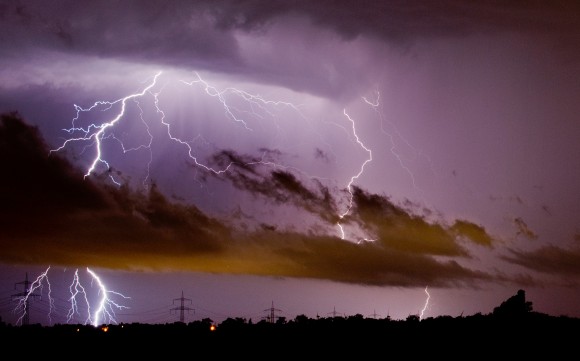Even though it meant the commencement of hurricane season, weather-beleaguered Texans are likely pleased that May 2015 has come and gone.
Both Texas and Oklahoma were pelted during the month of May with all kinds of violent and deadly weather, including hail storms, an unusually high number of tornadoes, high winds, torrential rains and massive flooding.
The Associated Press reported that at least 31 people were killed in storms that began in Texas and Oklahoma over Memorial Day weekend. Twenty-seven deaths were recorded in Texas and six in Oklahoma. At least 10 people were still missing as of June 1.
The Associated Press reported that Oklahoma’s emergency management director said while assessments are still underway, damage from severe storms that dropped historic levels of rainfall and spawned tornadoes and flooding across that state could reach $200 million
The USDA-Natural Resources Conservation Service reported that National Weather Service records show more than 35 trillion gallons of rain fell across Texas in May – enough water to cover the entire state in eight inches of water.
While the violent May weather – tornadoes and flooding in particular – caused significant property damage, the ratings agency A.M. Best suggests that insurers operating in Texas likely will not be subject to ratings actions as a result.
Though property insurers will face claims from tornadoes, wind and hail, in a briefing titled, “Southern Plains Rain and Flooding to Have Minimal Impact on Regional Writers,” Best noted that property insurers have relatively little exposure to flood losses as flooding is not covered in a standard homeowners policy.
At press time, the Federal Emergency Management Administration, which manages the National Flood Insurance Program, had not yet reported loss figures for Texas. The state ranks number two, behind Florida, in the number of flood insurance policies in force.
Auto insurers may be the hardest hit from the massive flooding that occurred in Texas. The National Insurance Crime Bureau estimates between 7,000 and 10,000 vehicles in Texas were impacted by the floods. The Insurance Council of Texas estimated that auto losses from flooding would reach $250 million and may go as high as $350 million.
Total insured weather-related losses for all of May in Texas could reach $1 billion, according to the ICT.
Still, A.M. Best said the “impact on most auto physical damage writers is anticipated to be mitigated given the generally large economies of scale of major writers in the market.”
The NICB warned that many of these flood damaged autos could be put up for sale without any indication that they were impacted by flooding. The NICB said it is working with law enforcement agencies, insurance and car rental companies to identify and catalog water-damaged vehicles to keep them from being resold to unsuspecting consumers.
In Texas, the highest number of weather-related deaths occurred in Memorial Day flooding in Wimberley when the Blanco River rose hard and fast. Others were killed in tornadoes in Van, Eastland and Milam County during May, the ICT reported.
Texas Governor Greg Abbott declared 70 Texas counties disaster areas as a result of tornadoes and flooding, and on May 29, President Obama issued a federal disaster declaration for Harris, Hays and Van Zandt counties.
In Oklahoma, 13 counties have been approved for federal disaster assistance.
The Texas Department of Insurance deemed the weather that occurred May 23 through May 30 in Harris, Dallas, Travis, Fort Bend, Tarrant, Bexar, Hays, Rusk, Randall, Williamson, Collin, Lubbock, Montgomery, Cherokee, Ellis, Denton, Wichita, Brazoria, Nueces, Johnson, Parker, Bell, Grayson and Bastrop counties a catastrophe for the purpose of claims processing.
The number of tornado watches in Texas during the month was three times higher than the norm, according to the storm prediction center in Norman, Okla.
Greg Carbin, warning coordination meteorologist for the center, said the state also had an explosion of super cell thunderstorms during May.
“There was no shortage of weather catastrophes this past month and insurance companies and adjusters have been working overtime in reaching all of those who have had property damage,” said Mark Hanna, a spokesman for the Insurance Council of Texas. “Building contractors and auto body shops will have plenty of work in the coming months.”
Joshua Jans, lead meteorologist for AnythingWeather, said 68 Texas counties had golf ball size hail or larger in May.
“Texas had 18 days in May where golf ball size hail was recorded and hail was reported in Texas for eight straight days from May 4 – 11,” he said.
Hurricane Season
June 1 signified the official start to the Atlantic hurricane season and forecasts predict fewer than normal named storms for this year.
Colorado State University researchers Philip Klotzbach and William Gray said cooler ocean temperatures and favorable atmospheric conditions likely will continue through the summer months, resulting in fewer hurricanes.
The Gulf Coast and East Coast both have a 15 percent chance of getting hit by a hurricane this year, well below the average of 30 percent, the researchers say. Their forecast released in April called for seven named storms, three of which are predicted to become hurricanes with wind speeds of 74 mph or higher.
But just one storm can make a huge difference. For instance, in 1992 only one major hurricane was predicted. That was the year Hurricane Andrew hit South Florida, including Miami, with Category 5 winds. Andrew caused $15.5 billion (1992 dollars) in Florida and Louisiana, making it at the time the costliest hurricane ever to hit the United States, according to the Insurance Information Institute. In terms of cost, Andrew was outranked by Hurricane Katrina, which devastated Louisiana in 2005.
Two of the nation’s costliest hurricanes caused damage in Texas: Hurricane Ike in 2008 ($12.5 billion total, $9.8 billion in Texas) and Hurricane Rita in 2005 ($5.6 billion total, $2 billion in Texas), according to the I.I.I.
Hurricane Alicia, which came ashore in August 1983 packing winds of 115 miles per hour, caused $3 billion in damage in Texas.
Insurance Council of Texas and Associated Press reports contributed to this story.
Topics Catastrophe Texas Auto Florida Flood Hurricane Oklahoma
Was this article valuable?
Here are more articles you may enjoy.



 MAPFRE Accuses AAA of Violating Long-Time Exclusive Marketing Agreement
MAPFRE Accuses AAA of Violating Long-Time Exclusive Marketing Agreement  Berkshire Hathaway Raises New CEO Abel’s Salary to $25 Million
Berkshire Hathaway Raises New CEO Abel’s Salary to $25 Million  ’60 Minutes’ Homeowners Ask Court to Force DFS to Divulge Heritage Probe Info
’60 Minutes’ Homeowners Ask Court to Force DFS to Divulge Heritage Probe Info  Private Equity Firms Expected to Unleash Middle-Market M&A Deals, Survey Says
Private Equity Firms Expected to Unleash Middle-Market M&A Deals, Survey Says 


